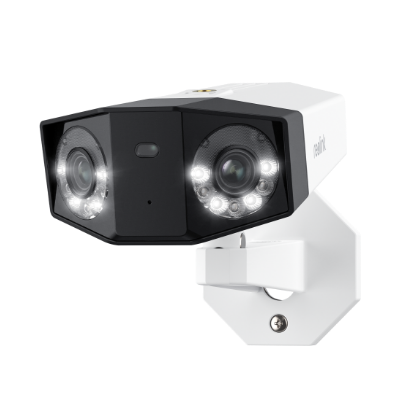1944p vs 4K: Which Resolution is Better?

You are just as likely to have heard of the 4K resolution as you are unlikely to be familiar with the 1944p. Both resolutions are pretty distinct from each other and have their particular applications.
In this article, we will compare the 1944p and 4K resolutions, exploring their features, advantages, and drawbacks. By the end, you'll have a clear understanding of the difference between both resolutions.
1944p VS 4K: Resolution Explained
The primary difference between 1944p and 4K resolution lies not only in their pixel count and dimensions but also in their aspect ratio and supported devices. 1944p resolution, with over 5 million pixels and dimensions of 2592 x 1944, typically has an aspect ratio of 4:3, which is commonly found in dashcam and a small number of security cameras.
On the other hand, 4K resolution, boasting over 8 million pixels and dimensions of 3840 x 2160, usually has a 16:9 aspect ratio, which is the standard for modern high-definition displays. 4K resolution is widely supported by various devices, including televisions, computer monitors, and cameras, etc. allowing for sharper and more detailed visuals.
What is 1944p?
The 1944p has a resolution of 2592 x 1944 pixels and boasts over 5 million pixels, resulting in increased detail and clarity compared to standard high-definition (HD) displays.
The "p" in 1944p stands for progressive scan, a technique of loading pixels on a screen to minimize flickering. This makes it excellent for capturing and viewing high-quality footage, which is why it is commonly found in dashboard cameras (dashcams). The ability of 1944p to display the entire image in one frame contributes to its superior visual experience, bridging the gap between HD and ultra-high-definition (UHD) resolutions.
What is 4K?
4K resolution, or Ultra HD (UHD), is a high-quality display standard commonly associated with modern TVs, monitors, and cameras. It offers a resolution of 3840 x 2160 pixels, totaling over 8 million pixels. The term "4K" refers to the approximate horizontal pixel count of 4000.
4K has become increasingly popular in the entertainment industry, allowing for producing and consuming content with exceptional visual clarity.
1944p VS 4K: Comparison Table
There are also other differences. Here is a chart to better compare 1944p and 4K from various aspects.
Applications of 1944p and 4K
Compared to the 1944p, 4K resolution is more widely adopted in several use cases. Here, we further discuss the typical applications of both resolutions.
Applications of 4K resolution
- Cameras: Using 4K resolution in cameras is beneficial when you want to capture high-quality, detailed footage. It is handy in professional videography, filmmaking, and photography, where you need the flexibility to crop, zoom, and edit without losing clarity. Additionally, shooting in 4K allows for better stabilization and image correction during post-processing.
-
Monitors: 4K monitors are an excellent choice for tasks that demand high levels of detail and clarity, such as video editing, graphic design, and professional photo editing. They provide a larger workspace and crisper images, making it easier to work with intricate details. Gamers and multimedia enthusiasts can also benefit from 4K monitors, which deliver immersive gaming experiences and sharp visuals when paired with compatible hardware.
-
TVs: 4K resolution is excellent for larger TVs (55 inches and above) as it enhances the visual experience on bigger screens. It lets you see more detail up close without pixelation, creating a lifelike and immersive viewing experience. With the growing support for 4K content in streaming services, Blu-rays, and game consoles, investing in a 4K TV is a good way to future-proof your entertainment setup.
-
Game consoles: Modern consoles like the PS5 and Xbox Series X support 4K gaming. When connected to a compatible 4K TV, these consoles offer stunning visuals with sharp details, vibrant colors, and enhanced graphics. 4K-optimized games provide immersive and visually impressive gameplay by utilizing the increased pixel count. While not all games are native 4K, upscaled content still brings noticeable improvements over lower resolutions.
-
Security cameras: 4K cameras are an excellent choice for those with a higher budget seeking a surveillance solution for large areas, as they provide the greatest detail and are suitable for warehouses, big box stores, construction sites, backyards, long hallways, and other expansive facilities. With superior clarity and increased pixel count, 4K cameras ensure precise identification, capture fine details, and offer effective digital zoom capabilities.
Applications of 1944p resolution
1944p resolution is widely used for dashcams and some security cameras.
-
Dashcams: 1944p is primarily found in dashboard cameras, which capture important details such as license plates, road signs, and events while driving. Compared to a traditional 1080p dashcam, it has more pixels and therefore offers more detail in recorded footage.
-
Security cameras: A 1944p camera offers a practical choice for those seeking a balance between image quality, storage space, and budget limitations. It is well-suited for medium-sized commercial or residential applications, including parking lots, driveways, and home entrances. By providing clear and detailed images, it ensures sufficient quality for accurate monitoring while still being mindful of storage constraints and cost considerations.
1944p Dashcam vs. 4K Dashcam: Pros and Cons
The 1944p resolution is primarily used in dashcams; however, some brands also feature 4K resolution. So what's the difference?
1944p Dashcam pros:
-
Good resolution: 1944p provides higher resolution than standard Full HD (1080p), offering better image quality and clarity for capturing objects on the road.
-
Balanced storage: Compared to 4K, 1944p videos have smaller file sizes, requiring less storage space on the memory card.
-
Lower cost: 1944p dashcams are generally more affordable than 4K models, making them a budget-friendly option. You can buy a dashcam with this resolution for less than $100.
1944p Dashcam cons:
-
Limited detail: While it offers better resolution than 1080p, it may not capture as much fine detail as 4K.
-
Advancement in technology: As technology progresses, 4K dashcams are becoming more prevalent, which might eventually render 1944p models less relevant in the future.
4K Dashcam pros:
-
Exceptional detail: 4K resolution provides the highest level of detail, ensuring superior image quality and precise identification of license plates, road signs, and other information.
-
Future-Proofing: Since 4K is currently the most popular resolution technology, you are guaranteed that your dashcam remains relevant even as video standards advance.
4K Dashcam cons
-
Larger file sizes: 4K videos have larger file sizes, requiring more storage space on the memory card, which might increase costs for larger storage capacities.
-
Higher cost: 4K dashcams are more expensive than 1944p models, making them less budget-friendly.
Additional Comparison: 1944p vs. 1440p vs. 2K vs. 4K
The chart below provides comparisons of 1944p and 4k to other resolutions.
Recommended Cameras with Higher Definition than 4K
As the demand for sharper and more detailed surveillance footage continues to rise, consumers are increasingly seeking cameras with resolutions higher than 4K. Recently, Reolink launched 16MP security camera. Let's have a look at it!
Reolink Duo 3 PoE is an exceptional 16MP security camera, offering unparalleled surveillance capabilities. With its groundbreaking dual-lens design, it provides a panoramic 180° view, ensuring comprehensive coverage of your surroundings. Additionally, features like motion tracking and color night vision further enhance its effectiveness in monitoring your property.
Groundbreaking 16MP Dual-Lens PoE Camera
16MP UHD, Dual-Lens, Motion Track, 180° Wide Viewing Angle, Power over Ethernet, Color Night Vision.
FAQs
1. Can the difference between 1944p and 4K be perceived on smaller screens?
The difference between 1944p and 4K resolution may not be noticeable on smaller screens but becomes more apparent on larger displays. Due to higher pixel density, the distinction is harder to perceive on smaller screens, such as smartphones. However, on larger screens like televisions or computer monitors, the superiority of 4K resolution in terms of sharper details and enhanced visual quality become more evident.
2. Can the human eye distinguish between 1944p and 4K resolutions?
The human eye can generally perceive the difference between 1944p and 4K resolutions, especially on larger screens or when viewed up close. However, the extent to which the difference is noticeable can vary among individuals. Factors such as viewing distance, visual acuity, and the size of the display all play a role in determining how easily the distinction can be perceived.
3. Is there a significant difference in video quality between 1944p and 4K?
Yes, video quality is significantly different between 1944p and 4K resolutions. 4K offers over 3 million more pixels than 1944p, resulting in higher detail, clarity, and vibrant colors. The increased pixel density provides a more immersive and visually appealing viewing experience, making it noticeable and enhancing the overall quality of videos, games, and movies.
Conclusion
Choosing between 1944p and 4K resolutions depends on your specific needs, budget, and the content you consume. Consider the factors discussed in this article and make an informed choice based on what matters most. Whether you choose 1944p or 4K, both resolutions deliver impressive visuals that can elevate your viewing experience.
If you think this article could be helpful to someone you know, please forward it to them. If you have other questions about other resolutions, leave a comment below!
Search
Be in the Know
Security insights & offers right into your inbox

